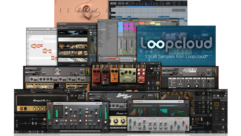
Auditorium Hall Upgrade at University of Rhode Island, Part 2
Jul 18, 2013 10:25 AM,
With Bennett Liles
Listen to the Podcasts

Editor’s note: For your convenience, this transcription of the podcast includes timestamps. If you are listening to the podcast and reading its accompanying transcription, you can use the timestamps to jump to any part of the audio podcast by simply dragging the slider on the podcast to the time indicated in the transcription.
At the University of Rhode Island, the expanding role of the Edwards Hall Auditorium required a new sound system that could handle everything from lectures to concerts and they called in Adtech Systems to set it all up. James Welsh and Charles Crane are back to wrap up their account of how it all worked, coming up next on the SVC Podcast.
SVC: James and Charlie, thanks for being back with us for part two on the SVC Podcast from Adtech Systems and the Edwards Hall Auditorium on the University of Rhode Island’s Kingston campus where you put in a new Bose RoomMatch sound system, revamped and modernized the whole thing. We talked in part one about the room acoustics and I wanted to get into exactly how things happened. What did you do when you first got in there? You knew what they had there so what did you start out with?
Charles: Sure. Well, the first thing we did was sort of a needs analysis phase where we talked to all the user groups of the room to understand how they use the room. Was the sort of quasi-theater setup still relevant? You know, what would they prefer if they could have their way, especially the people who use the room on a frequent basis; they had a wish list in their minds. So we talked to everybody and arrived at a basic approach that we were going to take out of the gate. After that we went back and measured the RT60 in the room to quantify exactly what was going on in there acoustically. We were doing acoustic modeling to design the system, and if the room exists, I always like to go back and measure the reverberation time just to validate the model and make sure that it corresponds to the reality. So then we built the model. We did several design integrations of the loudspeakers to try to come up with the best coverage, the best sound quality, the best speech intelligibility. And then once we arrived at a loud speaker design, we were simultaneously designing the front end of the room. They had their inputs and source requirements that they were looking for, quantity of microphones, and things like this. We reused some wireless mics and there were some front-end things that they reused, so that was good. We augmented that as well. And then after that we got the whole proposal together. We went back and using auralization, a portable auralization system, we demonstrated the loudspeaker solution to the customer so that they could hear sonically what their finished product was going to sound like so there would be no surprises. [Timestamp: 2:46]
It’s great when they have a chance to do that.
Charles: Oh yeah, because everybody, even lay people who aren’t CTS certified, they can say, “I’d like a little more low end, a little more thumb,” or “Is it going to be that clear,” or ‘It sounds kind of cavernous; what can we do?” So it’s a fabulous way to make sure that you’re on track with your design. And then from that approval of the sonic performance, we then submitted our proposal and that’s how we were awarded the job. [Timestamp: 3:18]
And you went with the Bose RoomMatch speakers. I was looking at some of the elements of that. It gets kind of interesting the way you can set it up. I think the RoomMatch RM12060 was part of this one. What does that have that works well for this situation? I know they have good power handling capability, something like 600W.
Charles: Yeah, yeah. And I forget how many different variations of the RoomMatch cabinet there are. There are many, many of them; all different dispersion patterns. And the 120’s by 60’s, those were the down-firing element. So because the room is exceedingly wide and not very deep, we were going with the widest cabinet with the 120-degree vertical. And the neat thing about the RoomMatch, too, is all the different dispersion cabinets; they all have a very similar sound quality and the way that the high-frequency devices are so close together when the cabinet is built up, I think it’s less than a 2in. gap in the two adjoining cabinets. That just keeps the high frequency in phase and you don’t get a lot of inter-speaker anomalies. This was, I think, the second usage of the RoomMatch for Adtech, so we were still kind of new with the product and it was nice that it turned out the way that it modeled and the way that we expected. Sonically it turned out really nice. [Timestamp: 4:36]
Well, I’m sure they appreciate the fact that you used it before and you decided to go back with it again. Nothing speaks to the quality and usability of it more than that.
Yep.
1
Auditorium Hall Upgrade at University of Rhode Island, Part 2
Jul 18, 2013 10:25 AM,
With Bennett Liles
I know they do a lot of things in this room. I think it’s mainly a lecture facility on the university campus, but I think they have various kinds of musical events in there, too?
Charles: Yeah, they do lots of concerts. You know, they do playback for like convocations and student orientations. [On] Earth Day they’ll have different multi-cultural bands playing all through the day. The room is truly multipurpose. So the lecture hall being the least taxing use of the system, all the way up to sort of full-out rock bands coming in. [Timestamp: 5:17]
Is that a complete system with its own amps or do you use some other amps with those speakers? Where did you put the amps?
Charles: It’s sort of a married system, so the Bose PowerMatch amplifiers, they’re in a rack room just behind the stage, so there the speaker wire runs are probably under 100ft. They’re 8-channel digital switching amplifiers and they do some amazing patented things that really blew me away. You know, you hear a lot of people talk about patents and great technology, but this one really yielded some benefit in terms of the fact that it’s eight channels of 500W and their max current usage is 15 amps, amazingly. They actually do some power recovery as the drivers are dampening, like the woofers are dampening they’re generating a little bit of current after the audio signal has ended and while the woofer is still coming to a rest. It actually does some power recovery. An amp like this I would typically expect to see 20-amp draw, something up there, but in times where we’ve gotten into the job before the electricians have had time to put the extra circuits in, I’m just amazed at the output we’re able to generate without thrown breakers. So it’s sort of a testament to the technology and honestly I don’t fully understand it. [Timestamp: 6:34]
Yeah, I was going to ask if you ran into any kind of interesting electrical or grounding issues on this one.
Charles: We did have to have the school install, I think it was four additional 20-amp circuits to accommodate the amps because there were four of the PM8500 amplifiers in that system. But no, everything was quiet. No ground loops. It was remarkably smooth from a power standpoint. [Timestamp: 6:57]
Are you using all eight channels of those PowerMatch amplifiers?
Charles: Yes, actually all eight channels of all four of them. The RoomMatch mid-high boxes are bi-amplified and the double 15 bass boxes, there’s one on top of each of the two arrays. Each woofer is amplified discretely as well. And then the under-balcony speakers are two circuits of 70V, so we used the whole thing. [Timestamp: 7:25]
So you got in there, got it all hooked up, and rang it out and got into the system testing. How did that work out?
Charles: It was fantastic. With a room that has only three-quarters of a second of reverberation at 1kHz, it was like tuning your living room. It was fantastic. And now that we have plenty of direct-field coverage, I think their request was they wanted 100dB SPL throughout the auditorium and we were measuring peaks of 110db to 112 dB. And the speech intelligibility, the STI scores were up in the .7 range, which is basically as good as you can get practically. And the frequency response was real nice. It dialed in real quick. And one of the nice things about the PowerMatch is they have the drop-down preset EQs for the different RoomMatch modules that you use, and then they have an array compensation EQ curve so as the array grows in length it just, by nature and by physics, gets a little bit tubby at the low bass and the array compensation menu cleans that up too. So it’s really a very efficient way. It helps tune the room quickly and efficiently and as an integrator, you know time is money. [Timestamp: 8:32]
And so what did they break this thing in on? Was it something easy like a lecture event or did they go right into a more ambitious music performance or what did they do first with it?
Charles: Yeah, I think we walked out of there and the next day was like a convocation with a chorus. They actually work with an event rental company down there that brings in a big mixing board for the front end that they patch into the system. They kind of put it through their paces and we’ve heard nothing be rave reviews. [Timestamp: 8:56]
Well, with a high-profile local event, you’ll hear some kind of feedback right away when they do something like that.
Yep.
So what’s coming up next for Adtech Systems? Have you got something coming up that you want to tell us about?
Charles: Actually a ton of bread-and-butter AV conference rooms, interestingly enough. There’s always a few interesting house of worship projects in the works. We finished up another RoomMatch room, a 1,700-seat auditorium. These big audio jobs kind of come along here and there, but a lot of real standard AV work.
James: We have one really unique project beginning at the Fogg Art Museum on the Harvard University campus; about a $2 million job that we’ll be beginning – actually it’s beginning right now. We’re doing a really nice performing arts space in that area as well. [Timestamp: 9:38]
Okay. Well it sounds like you guys are going to be staying busy and you’re going to become RoomMatch experts after a couple more of these things. I appreciate your taking the time James Welsh and Charles Crane of Adtech Systems and the Edwards Hall Auditorium at the University of Rhode Island modernized with Bose RoomMatch. Thanks for telling us about it.
2










